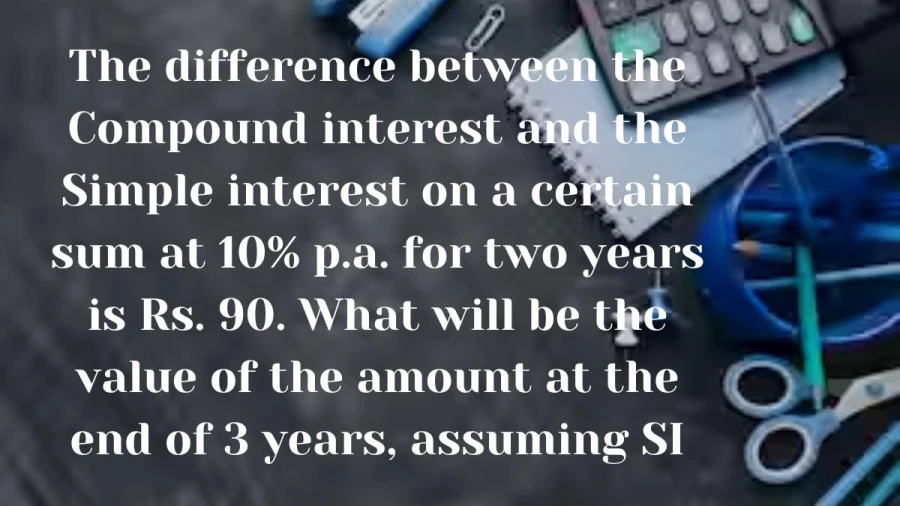If you happen to be viewing the article The difference between the Compound interest and the Simple interest on a certain sum at 10% p.a. for two years is Rs. 90. What will be the value of the amount at the end of 3 years, assuming SI? ? on the website Math Hello Kitty, there are a couple of convenient ways for you to navigate through the content. You have the option to simply scroll down and leisurely read each section at your own pace. Alternatively, if you’re in a rush or looking for specific information, you can swiftly click on the table of contents provided. This will instantly direct you to the exact section that contains the information you need most urgently.
The difference between the Compound interest and the Simple interest on a certain sum at 10% p.a. for two years is Rs. 90. What will be the value of the amount at the end of 3 years, assuming SI?
The value of the amount at the end of 3 years, assuming simple interest, would be Rs. 11,700.
To solve this problem, we first need to find the principal amount (initial sum) using the given information about the difference between compound interest (CI) and simple interest (SI).
Article continues below advertisement
Let’s denote:
- P = Principal amount
- R = Rate of interest (10% per annum in this case)
- T = Time (2 years in this case)
- CI = Compound interest
- SI = Simple interest
The formula for compound interest is given by: CI = P(1 + R/100)^T – P
And the formula for simple interest is given by: SI = P × R × T × (1/100)
Given that the difference between compound interest and simple interest is Rs. 90, we can set up the equation: CI – SI = 90
P(1 + R/100)^T – P – P × R × T × (1/100) = 90
P(1 + 10/100)^2 – P – P × 10 × 2 × (1/100) = 90
P(1 + 1/10)^2 – P – 2P × (1/10) = 90
P(11/10)^2 – P – (1/5)P = 90
P(121/100) – P – (1/5)P = 90
P × (121/100 – 1 – 1/5) = 90
P × (121/100 – 100/100 – 20/100) = 90
P × (1/100) = 90
P = 90 × 100 = 9000
So, the principal amount is Rs. 9000.
Now, to find the amount at the end of 3 years using simple interest, we’ll use the formula: A = P + SI = P + P × R × T × (1/100)
A = 9000 + 9000 × 10 × 3 × (1/100)
A = 9000 + 9000 × 10 × (3/100)
A = 9000 + 9000 × (30/100)
A = 9000 + 2700
A = 11700
So, the value of the amount at the end of 3 years, assuming simple interest, would be Rs. 11,700.
Difference Between Simple Interest and Compound Interest
Simple Interest:
- Simple interest is calculated only on the principal amount.
- The interest remains constant throughout the entire period.
- The formula to calculate simple interest is: I = P × r × t, where:
- I is the simple interest.
- P is the principal amount.
- r is the rate of interest per period (usually per year).
- t is the time period in years.
Compound Interest:
- Compound interest is calculated on both the principal amount and any accumulated interest from previous periods.
- The interest is added to the principal at the end of each compounding period, and subsequent interest calculations are based on this new principal.
- Compound interest typically yields higher returns compared to simple interest, especially over longer periods.
- The formula to calculate compound interest is: A = P × (1 + r/n)^(nt), where:
- A is the total amount after t years.
- P is the principal amount.
- r is the annual interest rate (in decimal).
- n is the number of times interest is compounded per unit t (usually per year).
- t is the time period in years.
In summary, the main difference between simple interest and compound interest lies in how interest is calculated and added to the principal amount. Simple interest is straightforward, calculated only on the initial principal amount, while compound interest takes into account both the principal and any accumulated interest, resulting in potentially higher returns over time.
Article continues below advertisement
Article continues below advertisement
Thank you so much for taking the time to read the article titled The difference between the Compound interest and the Simple interest on a certain sum at 10% p.a. for two years is Rs. 90. What will be the value of the amount at the end of 3 years, assuming SI? written by Math Hello Kitty. Your support means a lot to us! We are glad that you found this article useful. If you have any feedback or thoughts, we would love to hear from you. Don’t forget to leave a comment and review on our website to help introduce it to others. Once again, we sincerely appreciate your support and thank you for being a valued reader!
Source: Math Hello Kitty
Categories: Math

